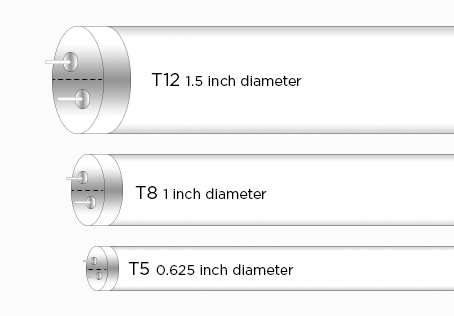
LED Tube Lighting Guide
LED tube lights are most often used in office lighting and can be used in both parabolic and indirect light fixtures. Designed to replace less efficient fluorescent tubes, LEDs consume significantly less power while emitting a similarly bright light with better color rendering and more control over color temperature. The lifetime of LED tube lights is much longer than fluorescents, some bulbs lasting up to 100,000 hours, meaning they burn out less frequently and require less maintenance.

Understanding LED Tube Size
LED tube sizes are determined by the diameter of the tube and the fluorescent wattage it’s replacing. The “T” stands for the tubular shape of the light bulb and the “F” stands for the bulbs fluorescent wattage equal. For instance, a F32T8 is a tube that is one inch in diameter and about the same Lumen output as a 32-Watt fluorescent tube. Linear tubes can primarily be found with a variation of two base types, bi-pin and single pin designs.

Direct Wire
Direct wire LED tube lights are the most energy efficient option for replacing fluorescent bulbs in commercial lighting fixtures because they do not require a power source controller, like a ballast, to operate. Unless you’re investing in LED ready fixtures or are comfortable working with electricity, you’ll need a licensed electrician to remove the ballast and rewire the fixture to run off the line voltage. This type of bulb is traditionally wired at just one end and requires a fixture to use non-shunted tombstones only. However, we now carry double-ended LED tube lights which are wired at both ends and can be used with both non-shunted and shunted sockets.
Ballasts are bypassed by cutting the hot, neutral, and socket lead wires that connect the ballast to the fixture. Then connecting the input wire to the output wire to connect the sockets directly to the line voltage. Once the fixture is rewired as needed, the bulb is installed as usual. If the LED tube doesn’t light up, check if it’s in the fixture backwards. The light will only come on if the correct side is connected to the wired tombstone. More detailed instruction can be found here.



Plug-n-Play
Plug-n-play tubes do not require any rewiring since they operate with the fixture’s existing ballast, so long as they are compatible with each other. Be sure to check the LED tube light’s ballast compatibility PDF. This type of bulb is the simplest way to replace fluorescent tube lights and start reducing energy costs. Keep in mind that the ballast is likely to fail before the LED bulb. When this happens, the LED will not operate until the ballast in replaced.
Hybrid
Hybrid LED tubes can be used with or without the ballast. These tube lights are often installed in fixtures with a compatible ballast until the ballast’s life has run out. Once the ballast is no longer working, it can be bypassed and the tube is used as a direct wire bulb. Hybrid LEDs can operate as a plug-n-play bulb with shunted or non-shunted sockets. However, if using with shunted tombstones when the ballast fails, be sure to rewire the fixture with non-shunted tombstones before using the fixture in direct wire mode.
LED Tube Light Color Temperature
LED tubes are available in a wide range of color temperatures, so it’s important to consider what Kelvin color is best for your application. The lower the Kelvin value of a bulb, the more yellow the light will appear. The higher the Kelvin value, the bluer the light. Be sure to keep your color temperatures consistent across each area. Offices, work-spaces, and garages benefit from lights that are between 4000K and 5000K. These color temperatures, cool white and stark white respectively, have been proven to help reduce eye strain and increase productivity.
We at 1000Bulbs.com only carry the best in LED tube lights. Still not sure which type of LED tube light to use? Give one of our lighting experts a call at 1‑800‑624-4488 for assistance.

